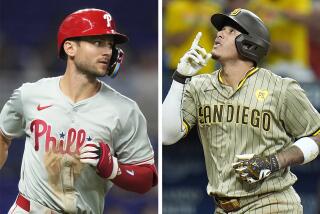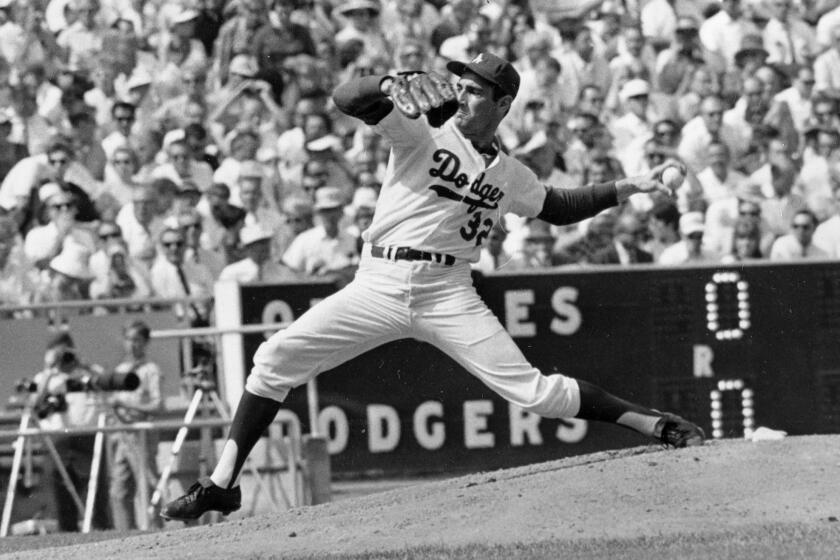Some People Smell a Rat in This Deal
- Share via
If I were the Dodgers, I would be very careful about dealing with Dorrel Norman Herzog, the manager of the St. Louis Cardinals.
Sitting in on a hand with Dorrel, otherwise known as baseball’s White Rat, is a little like getting in a game on a river boat with a guy wearing a beaver hat and a pinchbeck suit and carrying a gold cane. You should bring a priest. You’re better off buying a wristwatch from a guy with a suit lining full of them on a New York street corner. Or kneeling in an alley craps game with a guy named Slick.
Look what Dorrel has done in the grand old game:
In 1982, old Slick Herzog got Ozzie Smith from the San Diego Padres for Garry Templeton. Now, that’s Ozzie Smith as in the Wizard of Oz, maybe the surest thing for the Hall of Fame you will see on a baseball field today, the man who may be the greatest shortstop who ever lived. If he never got a hit with a bat, he’d stay in a lineup, because he gets plenty of hits with his glove. Two a day, usually. Still, he batted .303 last year. Templeton batted .222.
Score one for baseball’s Great White Rat.
Score two for what he did in 1985. At that time, Whitey hadn’t won a pennant in two years. He needed power. He already had baseball’s version of the Olympic 400-meter relay team, but no one who could hit the fences.
He got Jack Clark from the San Francisco Giants, one of the genuine power hitters of the game for--are you ready for this?--David Green, Gary Rajsich, Dave LaPoint and Jose Uribe. If someone did that on the New York Stock Exchange, they’d go to jail. Clark hit 66 home runs in what was, effectively, two seasons with the Cardinals. The only year the Cardinals didn’t win a pennant was the year he was on the disabled list for nearly the whole year (from June 25 on).
In 1981, Whitey got Willie McGee from the New York Yankees for somebody named Bob Sykes. The last time I looked, Sykes hadn’t made the big leagues yet, but Willie McGee led the league in hits (216), average (.353), triples (18), and he stole 56 bases in 1985.
The league should take out a policy against running into Whitey Herzog in an elevator. If Whitey calls, you should have your secretary say you’re not in and she doesn’t know when you’ll be back. The franchise you save may be your own.
So, now, the Great White Rat and Cardinal General Manager Dal Maxvill come dangling a left-handed pitcher, John Tudor, for a power hitter, Pedro Guerrero. It’s the Dodgers’ turn in the barrel.
On the face of it, it looks like a good deal. But with Whitey, who made it clear to Maxvill that he wanted Guerrero, you always have to assume the watch is hot, the diamond is glass, the lot is underwater.
There is an axiom in baseball trading: When in doubt, get a pitcher. John Tudor may be a good one. He was in 1985 when he won 21 games and got 21 out of 24 votes for second place in the Cy Young Award balloting (Dwight Gooden got all 24 first-place votes).
But Pedro Guerrero is a very good baseball player. Not as good as he thinks he is--but good. If he plays a full season, he bats .300, he hits 30 home runs, give or take a couple. He knocks in 85-100 runs. No one ever mixed him up with Pie Traynor in the infield or Joe D. in the outfield. But he will be missed in the middle of that Dodger batting order. When you had Kirk Gibson, Guerrero and Mike Marshall coming up, you had a mini-murderers row. You had nobody to pitch around.
Trades-that-help-both-clubs are as rare as rain in the Sahara. And Whitey Herzog has no reputation at all for helping anybody but Whitey Herzog.
If you’re going to sit down and play stud with Whitey Herzog, a good idea is to get him to roll up his sleeves first. A better idea is to say “Some other time, Whitey.” If you must deal, at least ask him for World Series tickets first.
More to Read
Are you a true-blue fan?
Get our Dodgers Dugout newsletter for insights, news and much more.
You may occasionally receive promotional content from the Los Angeles Times.









